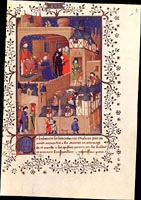
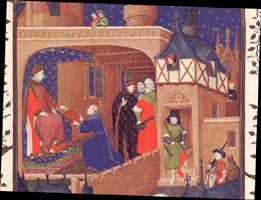
The consolidation of power of the kings of western Europe in fixed administrative centers from the mid-thirteenth century led to the creation of a distinct court culture. Aristocratic households became not only political centers but also artistic, intellectual, and cultural centers. As suggested in Chastellain's statement above, the aristocrat's power was directly reflected in the magnificence of his household. The later Middle Ages witnessed an expansion and elaboration of the structure of courts. By the fourteenth century, the court became divided between the Hall and the Chamber. The Hall consisted of the service side of the household which included the Hall, kitchen, and other service spaces. The Chamber was a more private space focusing on the bedroom of the Lord. The Chamber replaces the Hall as the center of power. The household was managed by the Lord Steward while the Chamber fell under the control of the Lord Chamberlain. The Chamberlain was primarily responsible for direct private service to the King as well as staging the public ceremonies. This division between the Hall and the Chamber was integral to Charles V's re-design of the Louvre where special attention is given to the elaboration of the King's and Queen's chambers (see also webpage entitled Palace Design and Court Structure). This twofold structure between what the English call the domus providencie (the Hall) and the domus magnificencie (the Chamber) is reflected in the frontispiece of a text by Pierre Salmon dated to about 1410:


The miniaturist here clearly divides the palace into two spaces. We see at the bottom a guard who controls access to the palace. He greets two petitioners at the gate of the palace. This outer space is the domus providencie. At the top we see another usher holding a mace and standing in a doorway decorated with the French royal arms. This usher controls direct access to the inner sanctum, the space of the King. This is the domus magnificencie. In the chamber at the top, Charles VI is enthroned and receives the text from Salmon while Jean de Berry and others look on. The room with the canopied throne can be identified as the chambre à parer or the chambre de parement. It is here that the King attended to affairs of state and received delegations and ambassadors. The artist's use of hierarchic scaling along with the attention to the dress of the figures including Jean de Berry's robes decorated with his symbol of the swan emphasizes the "magnificence" of this space of the King. The hierarchization of the court structure was directly reflected in the colors and materials of clothing used by the different ranks of nobility and royal office holders. The emphasis on the display of magnificence is suggested by seeing the parallel between the two primary actions in this space. Jean de Berry, who is well known during this period for his acquisitiveness and love of precious objects, raises his hand in astonishment as he looks apparently at a jewel around the neck of his companion. This parallels Salmon's action of giving the book which is also treated as a precious object through the artist's representation of the cover with gold decorations.
As suggested by this miniature, this court culture of the later Middle Ages was dominated by what has been characterized as the "politics of intimacy" where direct access to the prince was a sign of social and political status. The goal of any courtier was to have "sight of the royal face." To be appointed to the staff of the chamber of the King was a sign of great privilege and assured high status. To be a member of the chamber of the king was to be considered to be a member of his familia. At one time the term familiaris was exclusively reserved for members of the nobility, but by the thirteenth century the term could be applied to commoners as well including bankers, physicians, merchants and lawyers and even on servants in the household. In the fourteenth century we see the development of a new position at court: valet de chambre. This refers to the salaried employees in the hierarchy of court servants. Court singers, musicians, gold- and silversmiths, embroiderers, sculptors, and painters are included in the lists of valets de chambre. As a valet de chambre one would swear an oath to serve loyalty, receive a regular salary, be given robes fitting to one's station, sometimes be provided housing, and frequently have special status. For example, members of court were no longer regularly subject to local or municipal courts. They could be excused from taxes and exempt from local taxes. In ecclesiastical matters, they were answerable to the sovereign's personal chaplain. Perhaps the most important benefit of being a valet de chambre was having access to the ruler.
The relationship between members of the familia and the prince was a mutual one. Both profited from the relationship. The magnificence of the prince's household was at least in part reflected on who was a member of his household. The theme of the "familiarity" or "intimacy" between members of the household and the prince is found in both the literature and art of the fourteenth century. This is particularly evident in a series of presentation images included in manuscripts made for Charles V. The most famous of these is an image of Charles V receiving a Bible historiale from a member of his court, Jean de Vaudetar:
This frontispiece marks an important shift from earlier presentation frontispieces like the one introducing the Life of St Denis manuscript:
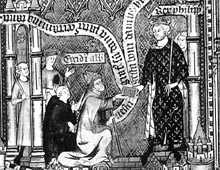
Note how in the earlier manuscript emphasis is placed on the formal regalia of the king wearing ermine-lined robes emblazoned with the fleur-de-lys and holding in his left hand the staff known as the "Hand of Justice." This scepter was given to the king at his coronation. It signified the king's absolute judicial power which was granted by divine right. Except for his name above, little attention is given to the individual identity of the king. Philip conforms to the royal type characteristic of this period. This dependence on type and delineation of regalia is characteristic of medieval ruler images. A fourteenth century image of the coronation of a King of England shows a comparable emphasis on royal symbols and lack of individualization:
In marked contrast, Charles V is dressed in the robes of a medieval cleric and instead of a formal crown wears a cap known as a béguin. This representation of Charles V in the garb traditional for a member of the university has been seen to construct Charles's identity as "sage" or "wise." The scribe Raoulet d'Orléans adds a poem at the end of the manuscript that refers to Charles as the "flower of wisdom."
Scholars have long noted the innovations in this miniature in the representation of space and the creation of an individualized as opposed to conventionalized portrait. The miniature has a plausible sense of space with what has been characterized as a diaphragm arch marking the entrance into the space and the shaded green floor which recedes as a groundplane into depth. The foreshortening of the canopy over the head of Charles V further creates a sense of space under which Charles sits. Comparably the faces of Charles and Vaudetar show strong individualization. Charles's long nose, thin face, and high cheekbones are all comparatively consistent in his portraits and conform to literary descriptions of his features. Even the detail of Charles holding a glove in his right hand might be a personal reference. Charles is known to have worn a glove to relieve the effects of gout. He has apparently taken off this glove to examine the book.* The portrait of Vaudetar likewise gives the impression of individualization.
Many of the characteristics noted here can be found in a group of other frontispieces for books made for Charles V. Most notably the French translation of Aristotle by Nicole Oresme contains two presentation images directly connected to the Vaudetar type. One introduces the dedication of the translation:
Nicole
Oresme's French translation of Aristotle's Ethics, Brussels,
Bibliothèque Royale, MS 9505-9506, c. 1372, folio 1 |
|
The other is incorporated into the frontispiece of the text itself:
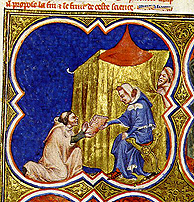 |
This formula is found introducing the texts of other authors as well. For example, the frontispiece of a copy of the Le Songe du Vergier showing an unknown author presenting the text to Charles V employs many of the same details with the addition here of the young Charles VI looking on:
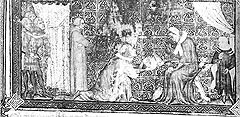
A difference
between the Vaudetar image and those in the Brussels' Aristotle and Le
Songe du Vergier manuscripts
is that in the latter
miniatures Charles V 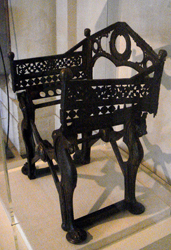 sits
on an X-shaped seat that is decorated with the heads and feet of lions.
This throne can be
related to a traditional form of French royal throne.
sits
on an X-shaped seat that is decorated with the heads and feet of lions.
This throne can be
related to a traditional form of French royal throne.  Ultimately the form of the throne goes back to the sella curulis of ancient Rome. An image of Justitia made for Marcus Aurelius shows the emperor dispensing justice from a sella curulis, The great seal
of Louis VII shows the king seated on such a throne. This was
based on a throne that Abbot Suger restored and that he believed dated
back to the time of the Merovingian King Dagobert. The lions are undoubtedly
a reference to the description of the throne of King Solomon (I
Kings 10:18-20). Appropriately it is exactly this type of seat that Solomon is seated on in a frontispiece in the Vaudetar Bible.This connection to Solomon would be relevant here
since these images construct Charles V as the Wise. Suger in restoring
the Dagobert throne believed that it was upon this throne that the kings
of France were accustomed to sit and receive homage from the great lords
of the realm.* Oaths
of loyalty would also establish the relationships in the court of Charles
V.
Ultimately the form of the throne goes back to the sella curulis of ancient Rome. An image of Justitia made for Marcus Aurelius shows the emperor dispensing justice from a sella curulis, The great seal
of Louis VII shows the king seated on such a throne. This was
based on a throne that Abbot Suger restored and that he believed dated
back to the time of the Merovingian King Dagobert. The lions are undoubtedly
a reference to the description of the throne of King Solomon (I
Kings 10:18-20). Appropriately it is exactly this type of seat that Solomon is seated on in a frontispiece in the Vaudetar Bible.This connection to Solomon would be relevant here
since these images construct Charles V as the Wise. Suger in restoring
the Dagobert throne believed that it was upon this throne that the kings
of France were accustomed to sit and receive homage from the great lords
of the realm.* Oaths
of loyalty would also establish the relationships in the court of Charles
V.
Solomon Frontispiece from the "Vaudetar Bible", The Hague, Museum Meermanno-Westreenianum, Ms. 10 B23, fol 317. Miniature is attributed to the Bible of Jean de Sy Illuminator. |
|
All of these images need to be seen in the context of court culture. In the Aristotle and Le Songe du Vergier miniatures, the curtains with figures peering around them clearly indicate the privacy of what is being represented. This is clearly the exclusive world of the King and members of his familia attached to his chamber. Although the author of Le Songe du Vergier is unknown, Jean Vaudetar and Nicole Oresme were members of the court of Charles V. In Raoulet d'Orléans poem at the end of the Bible historiale, Jean Vaudetar is identified as the "servant of the king." Vaudetar was a "valet de chambre of the lord king, chatelain and concierge of the Louvre" and eventually became "the king's counsellor in the Chamber of Accounts." In 1377 Nicole Oresme is listed among the counsellors of Charles V , and in his prologue to his translation of Aristotle's Politics, Oresme identifies himself as the chaplain of Charles V. His various ecclesiastical appointments including being made canon of the cathedral of Rouen in 1362, canon at the Sainte-Chapelle in 1363, and the bishop of Lisieux in 1377 were aided by the patronage of Charles V. Oresme undertook on Charles behalf a mission to Avignon to Pope Urban VI in 1363.*
It is significant that in addition to Vaudetar the two other documented individuals involved in the making of the Vaudetar Bibles were also members of the household of Charles V. The Vaudetar presentation image is not an anonymous painting, but as indicated by an inscription on the facing page it was painted in 1371 by John of Bruges, the king's painter ("iohannes de Brugis pictor regis"):*
In the year of the Lord 1371, this work was painted by order and in honor of the illustrious prince Charles King of France in his thirty-fifth year and the eighth year of his reign; and John of Bruges, painter of the said king, made this picture by his own hand.
This John of Bruges has been identified as Jean de Bondol who is listed in royal records as the pictor regis of Charles V. The position of pictor regis (painter of the king) had existed by 1305. The position entailed being available at the command of the king or members of his court to carry out any work they need. While they could paint altarpieces, the bulk of the work of the pictor regis would be decorative in nature including elaborately painted saddles, dining room chairs, the trappings for court festivities, etc. It is significant to note that this miniature in the Vaudetar Bible is a rare instance of the involvement of a pictor regis in manuscript illumination. Bondol's name first appears in royal records in 1368. That same year he ("our painter") received from the King a house in Paris worth 20 l.p. From then until he disappears from royal records in 1381, he received a high annual salary. A document of 1378 gives a sense of the parameters of the position of pictor regis:
Jean Bandol, painter of the king, wages of 200 l.p. each year, under the condition, that he holds himself available to serve the king in whatever painted works that the king orders to be done, as for any members of his household [famulo suo]. Johannes Bandol, pictor regis, ad vadia [ed. valia] de 200 l.p. per annum, tali conditione, quod tenebitur servire in omnibus operagiis picture, que rex precipiet fieri, tam pro se quam pro famulo suo [Rouse and Rouse, I, p. 394 n.4] |
The scribe of the Bible, Raoulet d'Orléans, was also a member of the court of Charles V. Raoulet began working for Charles between 1361-63. At this point, Charles was the dauphin serving as the regent during King John's captivity in England. Over the course of the next thirty-five years Raoulet was responsible for the writing or at least in part of more than twenty manuscripts of which a good number were made directly for the king. Raoulet did not work exclusively for the king, but he was on call to carry out any projects requested by the king or his "family." The dedicatory poem written at the end of the Vaudetar Bible by Raoulet provides us valuable hints about the making of this manuscript:
| Charles, most honourable king, flower of wisdom above all kings of the earth: To you, for the great good that abounds in you, this book is presented and given, and is herewith delivered to you on bended knee by your servant Jean Vaudetar, who is depicted here in the frontispiece. I have never before in my life seen a Bible so adorned with pictures, designed and made by one hand, for which he has made many comings and goings, night and day, through the streets; and much rain fell on his head before he reached its end. To the prince named above [Charles V], this book is delivered and given by the said Jean with a willing heart, I tell you no lie, on the twenty-eighth day of the month of March in the year 1372; and it is worth a thousand marks* |
The reference in this poem to the dedicatory frontispiece shows that the Vaudetar miniature was an integral part of the manuscript. The passage referring to the "comings and goings, night and day, through the streets" gives us a vivid picture of the production of the manuscript with the collaboration of different shops in its production. Richard and Mary Rouse (Manuscripts and Their Makers, p. 277) have suggested that Raoulet's involvement was not simply as the copyist of the manuscript, but since he was aware of the different stages of production, he was probably the libraire or the coordinator of the production of the project. It would have been his responsibility to distribute the different portions of the book to the miniaturists and decorators to complete their stints.
The involvement of Vaudetar, Jean Bondol, and Raoulet d'Orléans, all documented members of the household of Charles V, makes the production of this Bible a monument to the magnificence of the court of Charles V. Vaudetar, Bondol, and Raoulet all gained status by being members of the Charles V's household, but at the same time the quality of the court was assessed by its membership. Courts were judged by the reciprocal nature of the close relationship of the king to members of his court. The Vaudetar miniature's innovations of spatial illusion and individualization appear to be motivated by this emphasis on intimacy within the court culture. Bondol's attention to defining the space in the miniature should be seen in connection to the clear hierarchic experience of space in court culture. The space of the King was very controlled. The familiarity of Charles to Vaudetar is further emphasized by the way Bondol allows Vaudetar to penetrate the space of the king articulated by the canopy above. Unlike the traditional images of a king which put a emphasis on the formal regalia, here Charles V is represented as we have noted in the less formal dress of a medieval scholar. Comparably the individualization of the representation can be connected to the practice that only a member of the king's "familia" would have "sight of the royal face" and know the king on such intimate terms.
The individuality of the representation, relative informality, and references to privacy that are emphasized in these presentation scenes are a response to the change in court structure with power being centered in the king's chamber. An important literary parallel to these presentation images for Charles V can be found in Froissart's description of his visit to the court of King Richard II. Particularly relevant here is Froissart's account of his presentation of his book of poetry to the king:
| On the Sunday, the whole council were gone to London, excepting the duke of York, whom remained with the king, and sir Richard Sturry: these two, in conjunction with sir Thomas Percy, mentioned me again to the king, who desired to see the book I had brought for him. I presented it to him in his chamber, for I had it with me, and laid it on his bed. He opened and looked into it with much pleasure. He ought to have been pleased, for it was handsomely written and illuminated, and bound in crimson velvet, with ten silver-gilt studs, and roses of the same in the middle, with two large clasps of silver-gilt, richly worked with roses in the center. The king asked me what the book treated of: I replied, "Of love!" He was pleased with the answer, and dipped into several places, reading parts aloud, for he read and spoke French perfectly well, and then gave it to one of his knights, called sir Richard Credon, to carry to his oratory, and made me many acknowledgments for it. |
Froissart's attention to detail is probably less due to his urge for accuracy of detail than it is to be a sign of his success in negotiating the English court and gaining access to the king's chamber in the company of the king's closest advisors.
Charles V was clearly aware of ancient precedents for the magnificence of a ruler and his court being judged by its membership. As we will see when we discuss the court of the Duke of Burgundy, the example of the court of Alexander the Great was an important model. The intimacy of Alexander to members of his court was an important precedent for the court of Burgundy. Nicole Oresme in his dedication to Charles V of his translation of Aristotle's Ethics and Politics makes a clear parallel between himself and Aristotle who served as the "teacher and counsellor of the great king Alexander" just as Oresme serves "the most noble and excellent Prince Charles" :
Confident of the help of Our Lord Jesus Christ, at the command of the most noble and most excellent Prince Charles, by the grace of God, king of France, I propose to translate from Latin into French some books written by Aristotle, the supreme philosopher, who was the teacher and counsellor of the great king Alexander.*
The dedicatory poem of the Vaudetar Bible includes the curious statement that all of the miniatures were "designed and made by one hand" [D'une main pourtraites et faites]. This statement apparently contradicts the art historical evidence of the manuscript. In addition to Jean Bondol, the Master of the Bible of Jean de Sy did the major miniatures and many of the lesser ones, and apparently an assistant completed the remaining smaller miniatures. While Raoulet could be excused as the Rouses do by being "close enough to the truth," this statement seems to echo the reference in the inscription accompanying the frontispiece that states that the presentation miniature was by Bondol "with his own hand" [propria sua manu]. It is striking in this context to note the prominence of the pointing hand of Charles V in the presentation miniature, which significantly points to the image of Majesty shown in the book held by Vaudetar. The text facing the Majesty is the French translation of the opening of the Book of Genesis.

It seems that the Majesty of God is being related here to that of Charles V, who is, as the dedicatory poem asserts, the "most honourable king, flower of wisdom above all kings of the earth." This parallel between Charles V and God is found in the frontispieces made for Jean Corbechon's translation completed in 1372 of Bartholomaeus Anglicus' De Proprietatibus Rerum.
Charles V commanding Jean Corbechon to translate De Proprietatibus Rerum . |
This miniature comes from the Livre des propriétés des choses (Brussels, Bibliothèque royale, MS 9094) that was presented to Philip the Bold, the Duke of Burgundy in 1402. Although the original copy of the Livre des propriétés des choses that was given to Charles V has been lost, the extant copies reveal a clear program of illustration for the text. Donal Byrne commented on the special nature of the fourth scene or the one on the lower right.* At first sight this appears to be a standard presentation scene with the translator presenting the text to the patron, Charles V. Byrne in studying the series of frontispieces argued that the fourth scene in the original frontispiece that was included in the copy given to Charles V in 1372 illustrated the king commissioning the text. The inscription that accompanies the fourth scene in a number of the copies and was undoubtedly included in the king's 1372 copy gives the command of Charles V to Corbechon: "You translate into clear French the book of the properties" (Du livre les proprietez/En cler francois vous translatez). Byrne drew attention to the parallels between the scene of Charles V and the three Creation scenes: "we see that Charles V is calling something into being, like God, and, again like God, is doing so by means of a rhymed distich inscribed upon a scroll [p. 107]." Byrne situated these frontispieces within the traditional medieval formula: Rex imago Dei, "the king is the image of God."
In the Vaudetar miniature, it seems possible that the artist intended parallels to be drawn between the hand of God in Creation, the prominent hand of Charles V in the miniature, the reference in the inscription facing the miniature having been done "with [Bondol's] own hand (propria sua manu)," and the reference in the dedicatory poem to the pictures that were "designed and executed by one hand' ('d'une main pourtraites et faites'): the hand of one God, the hand of one King, and the hand of one artist. In his prologue to the Livre des propriétés des choses, Jean Corbechon characterizes himself as "...le plus petit de voz chappellains, et vostre creature et la creature de vos mains [the smallest of your chaplains, and your creature and the creature of your hands]."
It is worthwhile remembering that one of the most important symbols in the French monarch's regalia was the so-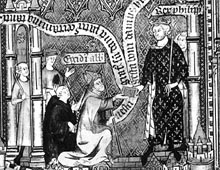 called Hand of Justice. We can see it included in many medieval images of the French king including the miniature of King Philip V receiving the text of the Life of St. Denis mentioned above. The Louvre owns a Napoleonic recreation of the Hand of Justice. Ingres' portrait of Napoleon includes this detail. There was also a popular story that the hand of the king could cure diseases.
called Hand of Justice. We can see it included in many medieval images of the French king including the miniature of King Philip V receiving the text of the Life of St. Denis mentioned above. The Louvre owns a Napoleonic recreation of the Hand of Justice. Ingres' portrait of Napoleon includes this detail. There was also a popular story that the hand of the king could cure diseases.
Raoulet's use of the verb pourtraites [D'une main pourtraites et faites] in the dedicatory poem is perhaps significant here. In a recent article, Stephen Perkinson* has discussed the descriptions of artistic activities in late medieval French literary texts. Of particular note is his discussion of the verb pourtraire. Perkinson notes that twelfth and thirteenth century uses denoted representations "of such perfection that they nearly replicated God's creation [p. 54]." Perkinson notes an important shift in the meaning of the verb pourtraire in the writings of Guillaume de Machaut and Jean Froissart, both writing in the second half of the fourteenth century. Perkinson characterizes Machaut's and Froissart's uses of the word pourtraiture as producing "a remarkably perfect representation of its subject, capturing all aspects of the subject's appearance [p. 54]." In contrast to earlier uses, Machaut and Froissart apply it to the work of human artisans who have the ability to make perfect likenesses [p.55]. The reference in the dedicatory poem to the miniatures as being d'une main pourtraites et faites would likely be understood as an assertion of abilities of image makers like Jean Bondol. When Raoulet says of the book " I have never before in my life seen a Bible so adorned with pictures...", he is directly praising the work of the "une main" of the artist, but he is also by implication praising the court of Charles V attested to by the magnificence of the Vaudetar Bible made by members of the king's court and praising the beauty of God's creation.
Addendum
The first of the great sequence of Books of Hours made for Jean de Berry is the so-called Petites Heures. The manuscript was probably begun in the 1370s by an artist who inherited the tradition of Jean Pucelle. Comparison of the Passion illustrations in the Petites Heures to those in the Hours of Jeanne d'Evreux confirms the link to the Pucelle tradition (for the complete series of Passion images see the end of the web page dedicated to the Pucelle Heritage).
This artist has been plausibly identified as the documented artist Jean le Noir who served successively Yolande of Flanders, John the Good, Charles V, and Jean de Berry. A document of 1358, states that Jean Le Noir left the service of Yolande de Flandre and along with his daughter Bourgot entered the service of King John the Good and his son the dauphin Charles. This document also records the gift of a house to Jean in Paris on the Rue Trousevache. In 1372 there are records in the accounts of Jean de Berry of gifts of cloth to Le Noir. In 1375, Le Noir is again listed as receiving payments from Berry. In this document he is listed as "enlumineur du roy et de mon dit seigneur." By 1375, Le Noir had moved from Paris to Bourges. Jean Le Noir apparently made his career as a court artist working in the service of aristocratic households. He seems to have been independent from the regular manuscript industry. Jean Le Noir's stint in the Petites Heures is likely to have been in the period of 1372 to 1375 when he is known to have been in the service of Jean de Berry.
For whatever reason, perhaps the death of Jean Le Noir, work was apparently suspended on the Petites Heures and probably re-begun around 1385. The artist who seems to have been responsible for this stage has been identified as Jacquemart de Hesdin who was in the service of Jean de Berry from 1384. Among the images attributed to Jacquemart in the Petites Heures is a miniature of Jean de Berry in prayer before the Virgin and Child. The individualized portrait of Jean de Berry and the setting with the curtains echo the frontispiece images of Charles V. 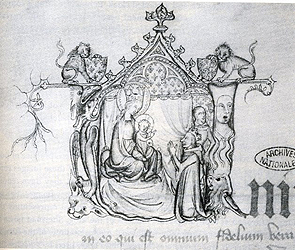 These elements are found in a historiated initial introducing a 1366 charter establishing commemorative masses at Rouen Cathedral. Charles V is shown in prayer before the seated Virgin and Child while a chamberlain holding a staff peaks around a curtain. It seems likely that Jacquemart borrowed the conventions from the Charles V presentation images for his miniature of Jean de Berry in prayer. The miniature gives visual form to the goal of Jean de Berry's prayer: he imagines himself as a member of the heavenly court of the Queen of Heaven who has granted the Duke private access to her chamber. The space can also be seen as the Duke's own private chamber as he prays at his prie dieu before the Virgin and Child who are presented in a pose so well known from devotional images. The tension between whose space is represented visualizes prayer which leads one from the physical to the spiritual. This anticipates the similar tension found in later paintings like Jan Van Eyck's Rolin Madonna. The marginal figure of a pauper holding a child presents a stark contrast to the Virgin and Child in the miniature. This social division anticipates the contrasts between the aristocratic and peasant worlds found in the calendar of the Trés riches heures.
These elements are found in a historiated initial introducing a 1366 charter establishing commemorative masses at Rouen Cathedral. Charles V is shown in prayer before the seated Virgin and Child while a chamberlain holding a staff peaks around a curtain. It seems likely that Jacquemart borrowed the conventions from the Charles V presentation images for his miniature of Jean de Berry in prayer. The miniature gives visual form to the goal of Jean de Berry's prayer: he imagines himself as a member of the heavenly court of the Queen of Heaven who has granted the Duke private access to her chamber. The space can also be seen as the Duke's own private chamber as he prays at his prie dieu before the Virgin and Child who are presented in a pose so well known from devotional images. The tension between whose space is represented visualizes prayer which leads one from the physical to the spiritual. This anticipates the similar tension found in later paintings like Jan Van Eyck's Rolin Madonna. The marginal figure of a pauper holding a child presents a stark contrast to the Virgin and Child in the miniature. This social division anticipates the contrasts between the aristocratic and peasant worlds found in the calendar of the Trés riches heures.